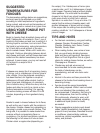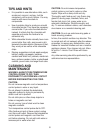6
SUGGESTED
TEMPERATURES FOR
FONDUES
The temperature settings below are suggestions,
and may need to be adjusted up or down
according to initial temperature of ingredients
being cooked, and amount and temperature of
food being dipped or cooked at any given time.
USING YOUR FONDUE POT
WITH CHEESE
Begin by tossing finely shredded cheese with at
least 1 tablespoon of cornstarch. Pour 1 cup of
liquid into the fondue pot and turn to setting 4.5
to bring liquid to a simmer, but not a boil. Once
the liquid is just simmering, reduce temperature
to 3.5 and add a small amount of the corn-
starch-coated cheese. Whisk until it melts into
the liquid. Continue, alternating between shred-
ded cheese and liquid, until all cheese has been
added and the desired consistency has been
achieved. In some cases, you may not need all
of the liquid in a recipe’s list of
ingredients.
If cheese ever seems like it is becoming clumpy
or stringy, put in a tablespoon of lemon juice or
cider vinegar. Once the preferred consistency
has been reached, stir together a couple of
tablespoons of liquid (either alcohol, broth or
lemon juice) and a tablespoon of cornstarch
(this is called a slurry). Whisk the slurry into the
fondue and allow to cook for a minute or two.
Reduce temperature to setting 3 for serving.
The entire cooking process will take 20 to 30
minutes, depending on the ingredients being
used.
Alcohol is used in cheese fondues for its flavor,
as well as the way it reacts with the proteins in
the cheese. It keeps cheese from separating or
clumping to create a very smooth fondue. That
being said, it is possible to make alcohol-free
versions without compromising flavor or
consistency. For alcohol-free options, substitute
the following for full amount of wine or beer:
Chicken stock or apple cider (depending on
the recipe), 2 to 4 tablespoons of lemon juice
or apple cider, and 2 to 4 tablespoons of apple
cider vinegar. Preparing fondue without alcohol
takes patience. You must add the shredded
cheese to hot liquid very slowly because cheese
melts more slowly in broth than in alcohol.
Sprinkle in no more than 1/4 cup at a time. If it
seems like the mixture is breaking apart, add
another tablespoon of lemon juice or vinegar.
If the recipe calls for adding more alcohol after
cooking, substitute 1 to 2 tablespoons of lemon
juice or vinegar.
TIPS AND HINTS
• Forthebestconsistency,usegoodmelting
cheeses: Gruyère, Emmenthaler, Fontina,
Cheddar, Monterey Jack, Swiss, Comté,
Raclette, Gouda, Edam.
• Whenmakingfondue,useawineorbeer
that you would enjoy drinking because
taste and flavor are important. Sauvignon
Blanc or Pinot Grigio/Pinot Gris is a good
choice for making cheese fondue, as well as
Champagne or Prosecco.
• Chardonnayandredwinesarenot
recommended for fondue cooking because
the taste of chardonnay can be
overwhelming, and red wine lacks color
appeal.
• Alcoholinthewineandbeerpreventsthe
cheese in the fondue from breaking down or
becoming clumpy.
• Fondueshouldbeservedimmediately
after being prepared. While it can be cooled
down and reheated, the consistency will
be compromised. If reheating, first bring to
room temperature; then turn to setting 4.
Stir continuously, allowing to warm until
desired consistency is reached, whisking
in additional liquid (alcohol or broth)
as needed.
• Dippingsuggestionsincludecrustybread
cubes, grissini (breadsticks), bell peppers,
grape or cherry tomatoes, blanched broccoli
or cauliflower, steamed baby potatoes,
cornichons, pickled vegetables, carrots and
celery, and pretzels.


















